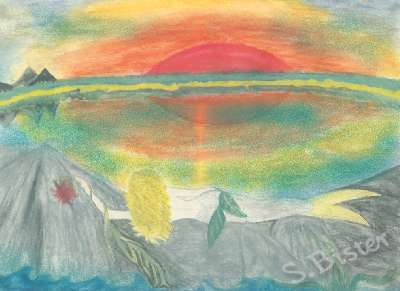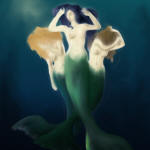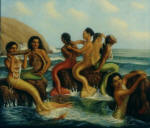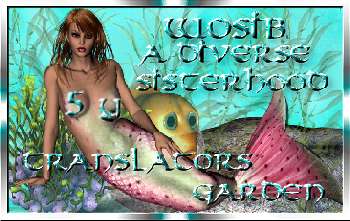|
KALEVALA
Kalevala, first published in 1835,with a
larger edition being published in 1849.
Kalevala is a Finnish national epos that
comprised Finnish folk stories gathered
together by Elios Lonnrot. It tells of the
weaknesses and spiritual strength of ancient
heroes, and has been translated into over
thirty languages with many artists having
received inspiration from it. Books four and
five deal with the story of Aino, a young
maiden who drowned herself and joined the
muses rather than marry an obnoxious, old
man. Here is an example of a watery female
figure, or mermaid, that was thought in
ancient Finland to be the spirit of a
drowned woman.

The History of Mermaids
Stories of Mermaids have been told for
centuries, be it in the form of folklores,
legends or faerietales. Images of this
creature have plagued artists and writers in
their efforts to bring to life the mystery,
beauty, and yes, eroticism of the mermaid to
their audiences. The role of mythology is
ever changing in our human society and it is
with this in mind that the time has come for
a stocktake of these mediums to establish
the different roles the mermaid has played
in human development. . .
Within the following your senses will be
taken back to the beginings of the mermaid
mythology. The mermaid was not always
portrayed the way it is today so the
information you are about to see is an
attempt to trace the mythology of mermaids
and to discover why the myth survived the
centuries.
With the use of four seperate categories you
are able to access the basic mediums that
are used to spread the legends and
folklores. The most available medium was
oral, word of mouth. Art and literature
follow close by, for as civilisation
developes, so too does the mermaid.

Painting by © Sirpa Bister 2005 aka Dreamer
Folklores & Legends
The mermaid and merman legends begin with
the worship of gods as have many
mythologies. This information has been
divided into three different catagories to
see different periods in the mythology of
mermaids. The earliest representations and
descriptions of these now well known
creatures can be traced back as far as the
eighth century BC. . .
THE THREE STAGES OF MERMAIDS MYTHOLOGY
Merfolk as Gods - a look at the birth of the
mermaid mythology and how it began as pagan
water deities and supernatural female water
beings.
Merfolk and Christianity - the role of the
mermaid mythology changed significantly with
the growth of the Chirstian Church, this is
a look at how and why the myth survived when
so many other pagan deities didn't and what
the new role of the mermaid was.
Merfolk and the Rise of Science - for a long
time the mermaid was believed to have
existed even by educated men, with the rise
of science and the Enlightenment the tides
turned back to try and disprove the
existence of such a creature as the mermaid.
This being done the role of mermaids changed
yet again.

Click to enlarge
MERFOLK AS GODS
THE BABYLONIANS were known to worship a
sea-god called Oannes, or Ea. Oannes was
reputed to have risen from the Erythrean Sea
and taught to man the arts and sciences. In
the Louvre today can be seen an eighth
century wall-scene depicting Oannes as a
merman, with the fish-like tail and the
upperbody of a man.
THE SYRIANS AND THE PHILISTINES were also
known to have worshipped a Semitic mermaid
moon-goddess. The Syrians called her
Atargatis while the Philistines knew her as
Derceto. It is not unusual or surprising
that this moon-goddess was depicted as a
mermaid as the tides ebbed and flowed with the moon then as it
does now and this was incorporated into the
god-like personifications that we find in
their art and the ancient literature.
Atargatis is one of the first recorded
mermaids and the legend says that her child
Semiramis was a normal human and because of
this Atargatis was ashamed and killed her
lover. Abandoning the infant she became
wholly a fish.
HOWEVER, NOT ALL ancient water gods or
spiritual personifications took on the form
of a mermaid or a merman all of the time.
Water-nymphs for example can be mistaken for
mermaids, they are beautiful in their
appearance and are also musically talented,
which mermaids are well known for, be it
their singing or playing of a musical
instrument. Sirens too are forever being
mistaken for mermaids. Even the ancient
writers and medieval Bestiary writers would
get the two confused or mention only one
when infact both have to be mentioned to
make sense of the literatures and
archaeological evidence. This is discussed
again below, where one can also see the
result of a siren/mermaid illustration. The
Siren and the Mermaid are two seperate
entities, one having the upperbody of a
young woman and the lowerbody of a bird, the
other the upperbody of a young woman and the
lower body of a fish.
THE INDIANS, amongst their many gods,
worshipped one group of water-gods known as
the Asparas,who were celestial flute-playing
water-nymphs.
IN JAPANESE AND CHINESE legends there were
not only mermaids but also sea-dragons and
the dragon-wives. The Japanese mermaid known
as Ningyo was depicted as a fish with only a
human head; where as the POLYNESIAN
mythology includes a creator named Vatea who
was depicted as half-human form and
half-porpoise.
GREEK AND ROMAN
MYTHOLOGY is often placed together as the
two are very similar and it is in the
literature from these cultures that one
finds the first literary description of the
mermaid, and indeed the mermen. Homer
mentions the Sirens during the voyage of
Odysseus but he fails to give a physical
description. The image seen here shows an
old black and white film of Homer's tale
depicting the sirens in mermaid form. Ovid
on the other hand writes that the mermaids
were born from the burning galleys of the
Trojans where the timbers turned into flesh
and blood and the 'green daughters of the
sea'.
Posiedon and Neptune were often depicted as
half-man and half-fish but the most popular
motif of the ancient world that depicts
mermen was the representations of the
tritons, TRITON being the son of the
powerful sea-god. A detail of the vase shown
and other typical triton motifs can be seen
from these periods in the Art Gallery.
Besides the vase is the trident, known to
have been carried by the sea-god and thought
to be magical, the figure of Poseidon in the
film Jason and the Argonauts, 1973 is shown
with the trident. Specimens of tritons in
classical times were said to be found at
Tanagara and Rome, according to Pausanias,
it is presumed by scholars today that they
were fakes, just like those mermaid remains
that one could find in the later nineteenth
century freakshows, but more information on
these later. The Nereids, who were the
daughters of Nereus and the Oceanides, who
were associated with Ocean and the Naiads
who lived in the fresh waters of the ancient
world, while being water creatures were
depicted as humans and not merpeople.

Click to enlarge
THE BRITISH ISLES too had their fair share
of merfolk mythology. The Cornish knew
mermaids as Merrymaids; the Irish knew them
as Merrows or Muirruhgach and some sources
write that they lived on dry land below the
sea and had enchanted caps that allowed them
to pass through the water without drowning,
while the women were very beautiful the men
had red noses, were piggy eyed, with green
hair and teeth and a penchant for brandy.
Other sources write that the Merrow were
believed to forebode a coming storm and W.
B. Yeats wrote in his Irish Folkstories and
Fairytales:
It was rather annoying to Jack that,
though living in a place where the
merrows were as plenty as lobsters,
he never could get a right view of one.
In the Shetlands the mermaid is known as the
Sea-trow who are able to take off their
animal skin that allows them to swim through
the water like a fish, and then walk on land
like humans.

THE NECK ARE to be
found in Scandanavia, along with the Havfrue
(merman) and the Havmand (mermaid), the neck
however were able to live in both salt- and
fresh-water. The Norwegian mermaid known as
Havfine were believed to have very
unpredictable tempers. Some were known to be
kind, others to be incredibly cruel; it was
considered unlucky to view one of these
havfine.
THE GERMAN MYTHOLOGIES OF mermaids are
plenty. There are the Meerfrau; the Nix and
the Nixe who were the male and female
fresh-water inhabitants and it was believed
that they were treacherous to men. The nixe
lured men to drown while the nix could be in
the form of an old dwarfish character or as
a golden-haired boy and in Iceland and
Sweden could take the form of a centaur. The
nix also loved music and could lure people
to him with his harp, if he was in the form
of a horse he would tempt people to mount
him and then dash into the sea to drown
them. While he sometimes desired a human
soul he would often demand annual human
sacrifices. There was also a more elvin kind
of Nixies that would sometimes appear in the
market, she could be identified by the
corner of her apron being wet. If they paid
a good price it would be an expensive year
but if they paid a low price the prices for
that year would remain cheap. In the Rhine
were to be found the Lorelei from which the
town took its name. The Germans also knew
the Melusine as a double-tailed mermaid as
did the British heraldry as well. There is a
double-tailed mermaid to be found in the
Art Gallery.
RUSSIAN MERMAID
MYTHOLOGY includes the daughters of the
Water-King who live beneath the sea; the
water-nymph that drowns swimmers known as
the Rusalka and the male water-spirit known
as the Vodyany who followed sailors and
fishermen.
THE AFRICANS BELIEVED the tales of a
fish-wife and river-witches.
What we have seen here is the beginings of
the mermaid mythology that starts with the
merman depictions of water-deities and other
such pagan identies. The stories of mermaids
as one may think of today, were formed after
the rise of Christianity.

MERFOLK AND
CHRISTIANITY
THERE IS A THEORY THAT during the
suppression of pagan deities the mermaid and
other minor supernatural beings were not
seen as a threat to the growth and
popularity of CHRISTIAN beliefs. Some
writers even go so far as to believe that
the Church actually believed in the mermaid
mythology, and for two particular reasons;
the first is that the mermaid served as a
moral emblem of sin, the femme fatale label
we know so well was nurtured with this form
of thinking; and the second was the quality
of evidence from contemporary and ancient
authors on the existence of mermaids added
to this 'belief' the Church found in
mermaids.
THE SYMBOL OF THE MERMAID with her comb and
mirror in hand seems to first be depicted
during the MIDDLE AGES. This came to
represent to the Church vanity and female
beauty which could cause the destruction of
men. And so the mermaid mythology turned
from that of near godlike status, including
the fear that the sirens brought, to one of
aesthetic values. The mermaid became a focus
for misogynists and as thus rather than
causing fear in the laity the mermaid became
even more fascinating.
THE BESTIARIES OF the early middle ages
included the siren and not the mermaid. As
the two creatures became confused in popular
beliefs and cultures so too did the bestiary
writers confuse the two, as can be seen in
this illustration of the siren, complete
with a mermaids tail. Mermaids were well
known in the bestiaries of Physiologus and
his predecessors, where they compiled the
zoological information of 'real' animals.
Mermaid were believed to exist even by the
most educated men.

IN 1403 A MERMAID was apparently found
stranded in the mud after a storm in West
Friesland. She was then taken, clothed and
fed ordinary food. Some say that she lived
for fifteen years in capture, trying to
escape constantly; she was also taught to
kneel before the crucifix and spin but she
was never able to speak.
RAPHAEL HOLINSHED, IN HIS CHRONICLES OF 1587
wrote that in the reign of either John or
Henry II, some fishers of Oreford in
Suffolk, caught a man-shaped fish, who would
not or could not speak, ate fish be it raw
or cooked and finally escaped after two
months, back to the sea. There are detailed
accounts of recorded sightings that are
mostly from the 1800's that can be read in
the Sightings page.
IN LITERATURE THE MERMAID began to be used
as a description of women, rather than an
identification of the creature herself. The
mermaid had become a metaphor! Chaucer takes
the mermaid and uses her as a scholarly
metaphor for beautiful but dangerous song.
Shakespeare is known to have used such a
divice; Comedy of Errors for example III.
ii, Antipholus of Syracuse to Luciana:
O, train me not, sweet mermaid, with thy
note,
To drown me in thy sister's flood of tears:
Sing, siren, for thyself and I will dote.
Oberon's vision of a mermaid in
Shakespeare's A Midsummer Night's Dream
II.i, is not however used as a metaphor, it
is not however seen on stage either:
Once I sat upon a promontory,
And heard a mermaid on a dolphin's back
Uttering such dulcet and harmonious breath
That the rude sea grew civil at her song
And certain stars shot madly from their
spheres,
To hear the sea-maid's music.
John Donne however
uses the mermaid as myth in his sceptical
Song where he doubts constancy in women.
More likely than finding this constancy in
women he believes would be to:
Goe, and catche a falling starre,
Teach me to heare Mermaids singing,
Or to keep off envies stinging.

Here is a gift to you, from Translators
Garden, created with love *S*



All
material, webset, graphics & creations were
made by © Sirpa Bister 2005 aka Dreamer at
DDezign's.
The research for material on this page; by
Sirpa Bister aka Dreamer, Assistante Head
Translator of WOSIB. All is made at the
behalf of WOSIB Translators Garden for to
celebrate the 5th year of WOSIB, and may not
be copied, duplicated or used without
restrict permission of the respective owner.
Some
of the beautiful tubes used on the graphics
created on this page, are from
Outlaw by
Dezign
|